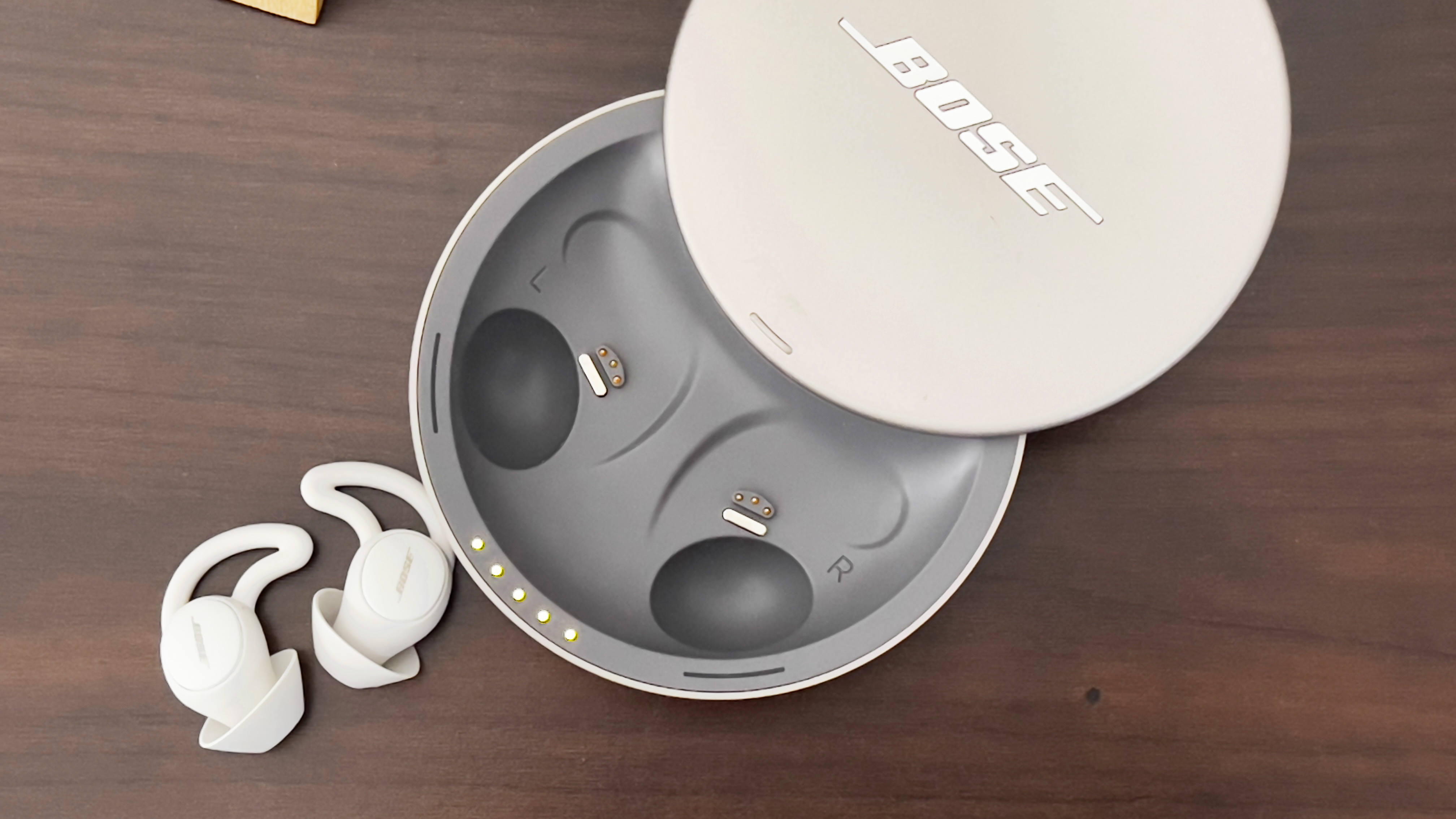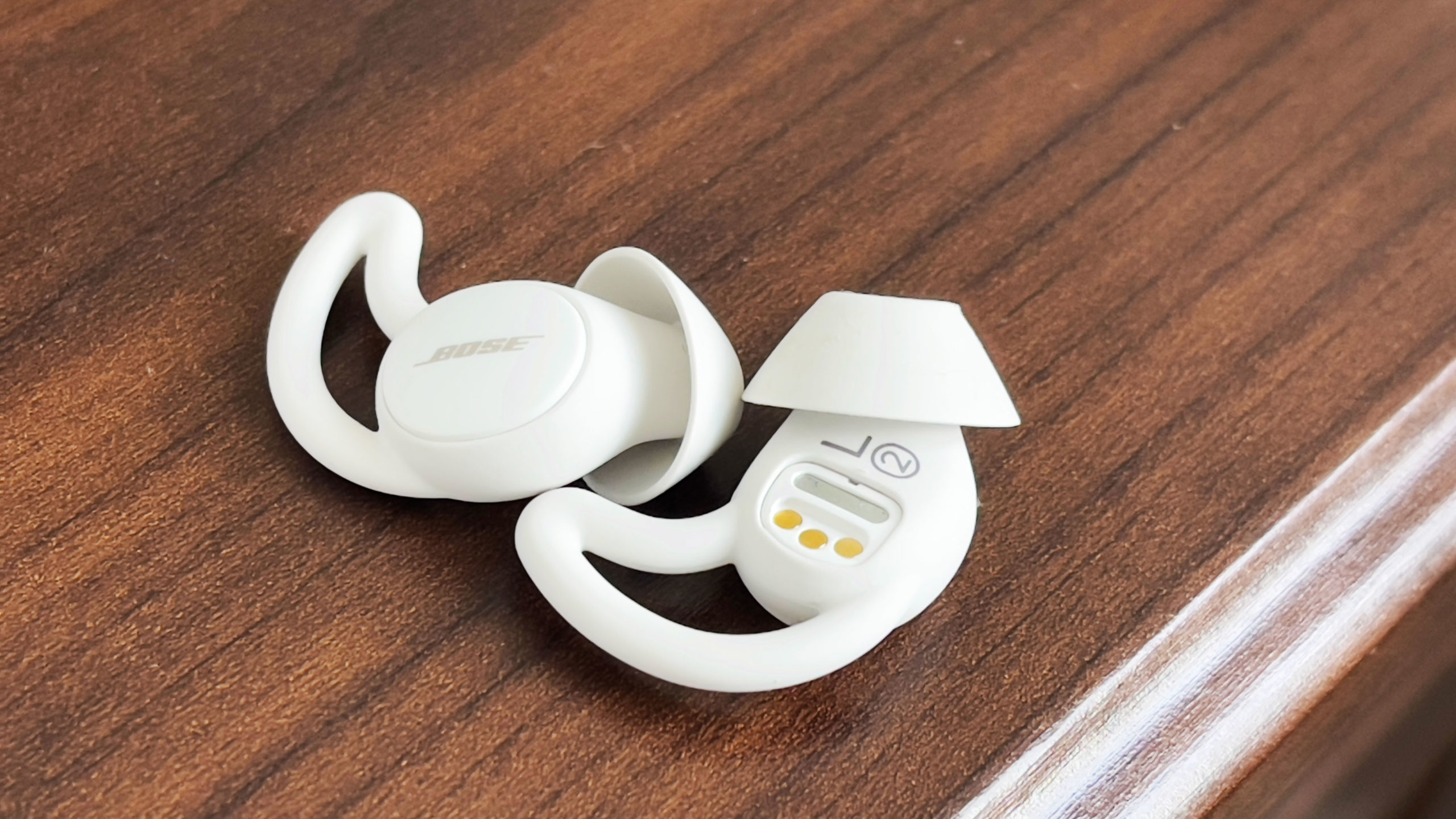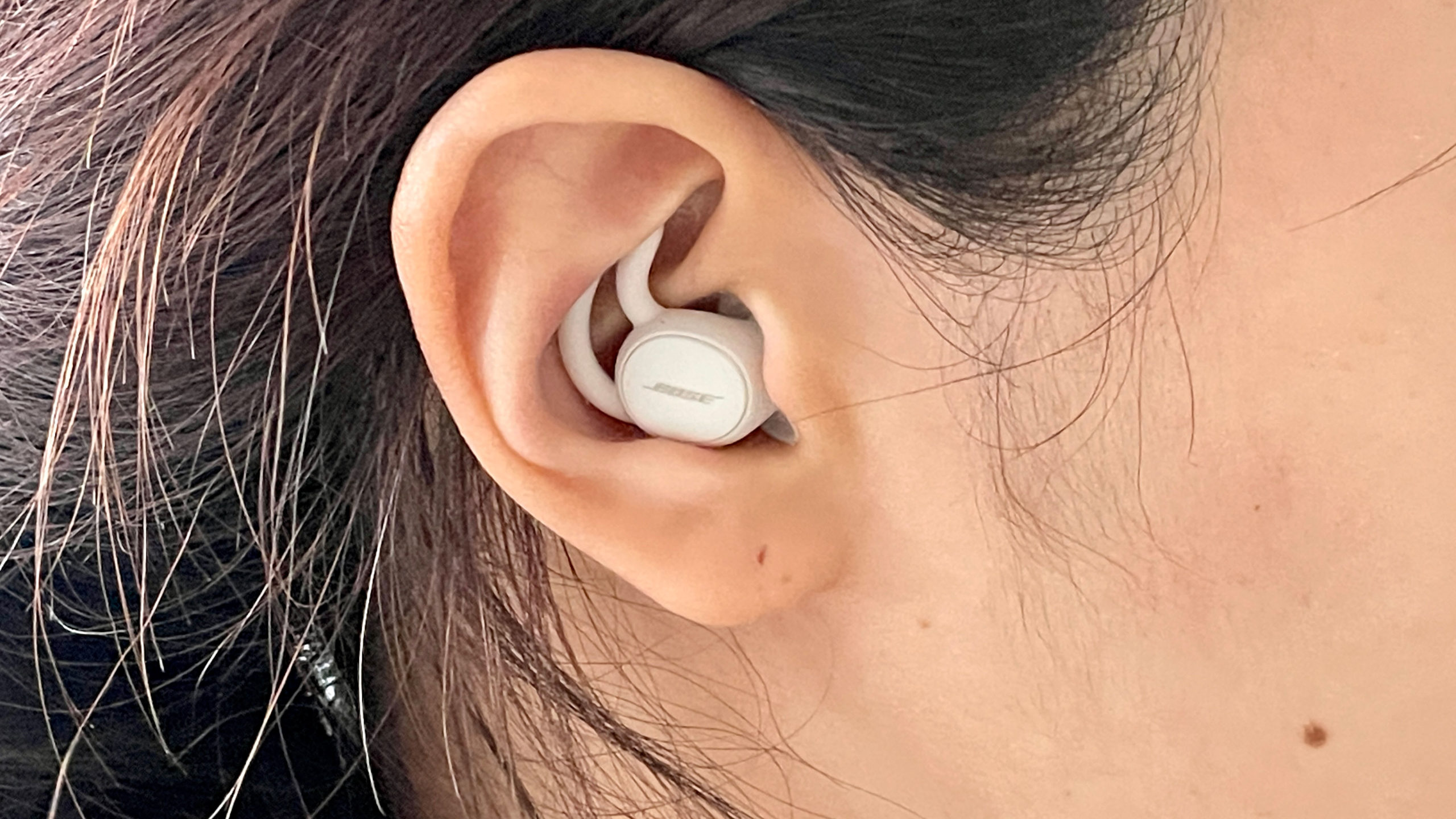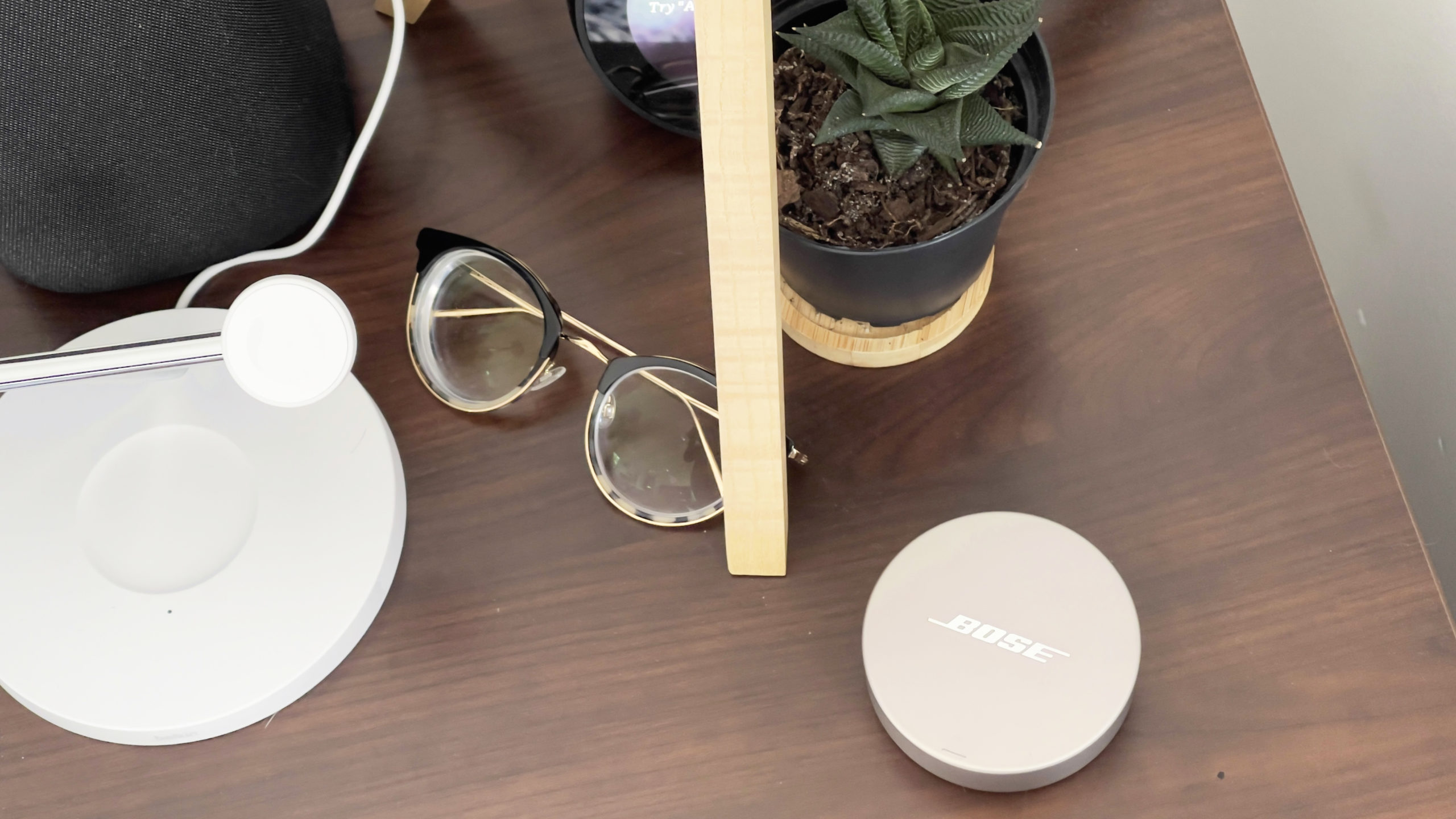The universe conspires against my beauty rest. My husband snores. Not every night, but when he does, my bedroom becomes the Thunderdome. Most nights, my cat yowls at 4 a.m. for more food, and at 5 a.m., bats my face with his paws until I raise the window blinds so he can stare at pigeons. My geriatric dog cries at 2 a.m. and 6 a.m. because her bladder is small and she has to pee. So really, I volunteered to review the Bose Sleepbuds 2 because I don’t remember the last time I slept a full, uninterrupted eight hours.
The premise behind Bose’s Sleepbuds is simple: You wear the earbuds to bed, and they block out ambient noise using masking sounds that you load up from the companion app. For the record, these don’t have active noise cancellation. It’s more like sticking a tiny white noise machine in your ear. At $379.95, however, these are an expensive alternative to the dozens of mindfulness apps out there with sleep soundscapes. That’s especially true when you consider that these earbuds aren’t capable of streaming music or podcasts. You can only play a selection of masking sounds that you download directly from the Bose Sleep app.

Bose Sleepbuds 2
What are they?
Wireless earbuds to help you sleep!
Price
$379.95, 90-day free trial
Like
Well-designed. Battery is more reliable than first-gen version. Solid connectivity. Expanded sound library. Helped me get an uninterrupted night's sleep.
No Like
Too expensive. Can't play your own music or podcasts. Phone-free mode disables alarms. You have to be very intentional with how you use them.
The original Sleepbuds (which also cost around $350) had a loyal fanbase, though there were several problems. They were ultimately discontinued due to battery issues, but customers also reported spotty connectivity and the buds failing to charge because they didn’t sit properly on the case’s charging nodes. With the Sleepbuds 2, Bose seems to have really taken that feedback to heart. This time around, the battery has been replaced with a more reliable one, the Bluetooth radio upgraded, the Bose Sleep app redesigned, the sound library expanded, and a third prong plus magnets have been added to the case so the buds automatically snap into place when charging. Another issue customers had with the previous generation was “pillow squeak,” a problem where side sleepers were woken up by the noise of the buds rubbing up against a pillow. With the Sleepbuds 2, Bose says it’s solved that problem by adding a special anti-friction coating.
I was hopeful, but intensely sceptical when I unboxed the Sleepbuds 2. I’ve tried sleeping with my AirPods Pro and it’s never worked for me. Either I wake up because they’re too uncomfortable, or the next morning I’m crawling under the bed to find a missing, dead AirPod. So I was pleasantly surprised with the design of these buds.
The buds themselves are incredibly light at just 2.27 g and come with three sizes of ear tips. According to Bose, getting a proper fit is key as the whole noise-masking thing doesn’t work too well if you don’t get a tight seal. I found the medium size fit me well and were comfortable. Another thing I appreciated was how the buds lay flush with my ears. Even when I slept on my side, the buds never fell out or got caught on my pillow. I also never experienced pillow squeak, so I guess that anti-friction coating did its job.

I’m also a big fan of the case. It’s not an eyesore on my nightstand and it’s the perfect size to toss in a purse or travel bag in the future where we’re all able to travel again. As for charging, we love USB-C compatible gadgets, and the LED battery indicator lights are simple and intuitive. The magnets near the charging prongs were also a good addition, as I never had to fiddle with the buds to make sure they attached properly.
Setting these babies up was easy and connectivity was reliable. During my testing, there was only one instance where my phone had trouble finding one of the earbuds — and that was easily fixed by putting them back into the case and taking them out again. The buds also were quick to connect with my phone, which is clutch when all you want to do is fall face-first into your pillow.
Bose has greatly expanded its library of sounds. There are now more than 50 soundscapes to choose from in three different categories. The first is noise-masking sounds, which range from warm static and the hum of an engine room to crackling campfires and ocean swells. The second category, naturescapes, feels nearly identical but I guess they’re more… nature-y. Honestly, I’m not too sure why these categories are separate. Bose contends noise-masking sounds are optimised for covering up ambient noises like traffic, snoring, and conversation. Meanwhile, naturescapes are meant to transport you to other locales. Trust me when I say there’s not much of a difference. The third category, tranquilities, is new. I can only describe the tranquilities category as the type of woo-woo synth tones you find at a hippy-dippy yoga studio. Cool if that’s your thing, but personally I hated all of them.

Overall, these are good improvements and the design itself is solid. That said, the Sleepbuds 2 aren’t perfect. My biggest gripe that you have to be super intentional in how you use them. Because the noise-masking sounds are stored locally on the device — they’re not streamed — you have to transfer any new sound you want to try from your phone ahead of time. The transfers are relatively quick, but it’s just long enough to be annoying when you’ve had a rough day. The same is true for updates. Those take 5-10 minutes. Not terrible, but I put off an update for days because I was tired and it was inconvenient.
If you’re not keen on planning ahead, you can put the buds in a phone-free mode. In that mode, the buds will play a pre-selected sound so you can skip connecting to your phone and go straight to sleep. While that feature was neat, you have to intentionally set the buds to that mode beforehand — and doing so has its drawbacks. For instance, I really liked the buds’ alarm feature, which gradually increases in volume at your chosen wake-up time. It’s a great option if you and your partner need to wake up at different times. The problem is the buds rely on your phone to tell time. That means alarms don’t work in the phone-free mode because the buds have no idea what time it is. When I’m sleepy, I have zero brain cells to remember which mode the buds were in, and no patience to decide whether I want to prioritise convenience or waking up on time. So while I appreciate the phone-free mode, it would’ve been nice if I could have that and the alarm.
In switching to a new, more reliable battery, Bose also had to sacrifice battery life. While the original Sleepbuds could go for 16 hours straight, these can only for 10 hours. That wasn’t really a problem for me, as in my old age, I am physically incapable of sleeping in. As for charging, I only had to plug in the case every four or five days.

Ultimately, these buds aren’t worth it unless they help you sleep. So did it work for me? Yes and no. Finding the optimal volume — loud enough to mask the meowing cat, but quiet enough to fall asleep — was tricky and I didn’t get it right for the first few nights. (Also, there’s no sound on Earth that can stop a persistent cat from smacking you awake.) That said, I did sleep through more of my pets’ shenanigans. Instead of waking up five or six times a night, I woke up “only” two or three times. Plus, I did manage one night of interrupted sleep using the buds. That’s a huge win in my book. Anecdotally, I felt like I fell asleep faster on nights I used the buds, but that could’ve also been a placebo effect.
Even though these buds are probably the best possible design for sleeping, not everyone will find them comfortable. I tested these for about two weeks, and the first few times I tried them, I woke up in the middle of the night to take them out. It just felt odd. Although I eventually got used to it, I still occasionally wake up with a mild ache around the entrance to my ear canal.
I suspect whether the Sleepbuds 2 are worth it will be different from person to person. You won’t know how well it works for you until you try them yourself, and $379.95 is a lot to ask of someone for a gadget that might not work. However, Bose does offer a 90-day trial, so if you’re inclined to try these — you might as well. To be completely honest, I didn’t find the soundscapes to be that different from using the Calm app, which is more affordable at about $90 per year. It was mostly that the noise was closer to my ear, so it was easier to ignore disturbances. That’s not nothing! It made a noticeable difference for me. It just may not work perfectly every single time, and you have to be patient enough to experiment.
If you don’t have trouble sleeping or only experience occasional disturbances, you should obviously save your moolah. Even with a trial, these are so expensive that I’d only recommend them if you’ve tried every other option. It might also be worth it if, like me, you have a snoring partner who can’t be effectively drowned out with a white noise machine or phone alone. Personally, I won’t use these every night — but you can bet I’ll reach for them when my pets and husband are too loud to ignore.
